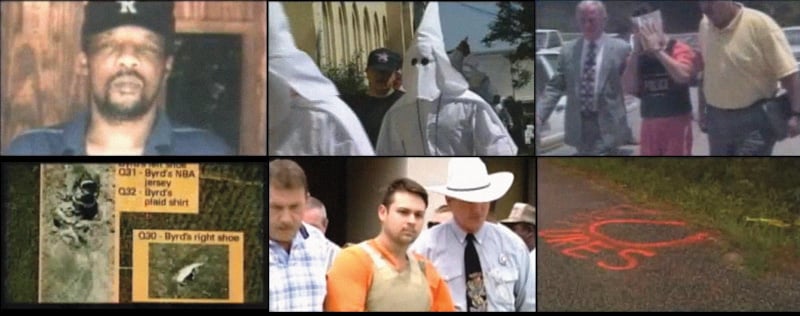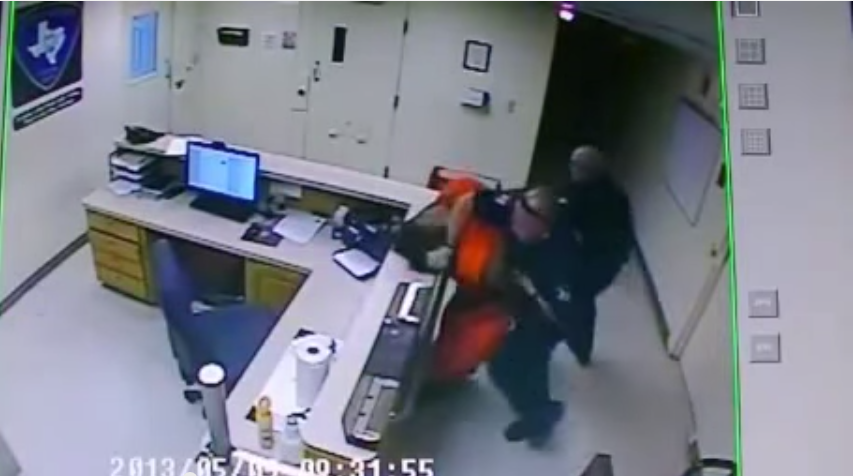
Long Road Out of Jasper: A Documentary Chronicles James Byrd Jr.’s Life and Tragic Death
A version of this story ran in the July 2013 issue.
Above: Scenes from Byrd: The Life and Tragic Death of James Byrd Jr.
Fifteen years ago, on a hot June night in the small East Texas city of Jasper, James Byrd Jr. left a party at a friend’s house and began the long walk to his home on the other side of town. Accustomed to catching rides with passing drivers, the 49-year-old African-American apparently didn’t hesitate when a pickup stopped and a white man he was acquainted with, Shawn Berry, offered to take him home. Inside the truck were two other white men, Lawrence Brewer and John King, both of whom had ties to white supremacist groups in and out of prison. Byrd never made it home.
When the story of the abduction and murder of James Byrd Jr. hit the next day’s news, it was as if a bomb had exploded in the complacent consciousness of contemporary America. The details of the crime were almost too horrible to believe, but anyone familiar with the history of the American South could recognize the echoes of a not-so-distant past filled with arbitrary white-on-black brutality, mob justice, torture and lynchings. Berry, Brewer and King had driven Byrd to a remote country road where they beat him and chained him to the back of the truck by his ankles. The men then dragged Byrd for three and a half miles. According to the autopsy report, Byrd was most likely conscious most of that time, right up to the moment his head was severed. Police found Byrd’s remains in 81 places along the road. By the end of the day after the crime, all three suspects were in custody.
While Byrd’s murder shocked the world, what surprised comedian and longtime civil rights activist Dick Gregory most was the speed with which news of the crime spread. In the documentary Byrd: The Life and Tragic Death of James Byrd Jr., directed by Eligah and Sharon Jason, Gregory marvels at how quickly reporters from the lurid world of 24-hour news picked up on the story and descended upon Jasper. Gregory, who is old enough to remember the media’s indifference to pre-civil rights-era horrors, viewed the sensationalist, echo-chamber omnipresence of the media during the Byrd affair not as a cause for cynicism, but as an indication of progress: That the media cared about a lynched black man in Texas, much less that they cared with such vigor, came as a shock to people who had long since grown jaded about the country’s indifference to racial violence.
Gregory recalls the story of Emmett Till’s mother, who, in 1955, demanded an open casket at her son’s funeral so that his marred face and body would be displayed for all the world to see. When a picture of Till’s unrecognizable corpse appeared on the cover of Jet Magazine after that funeral, lynchings nearly ceased in America, Gregory says. As disgraceful and shameless as the media can be in our age of saturation coverage, overwhelming television interest in an injustice like Byrd’s murder (no matter how salacious, titillating and profit-driven that interest might be) is better than indifference. Gregory’s words are almost enough to make you respect the workings of Fox and MSNBC. Almost.
The media’s response to the murder of James Byrd Jr. was a sign of America’s glacial evolution toward something like racial equality, as was the tearing down of a fence between the black and white sections of Jasper’s cemetery and the far more significant passage by the Texas Legislature of the James Byrd Jr. Hate Crimes Act in 2001. But it’s too much to hope that one incident can entirely change entrenched attitudes. Eventually the cameras and reporters head back to the coasts, and life moves back toward normal. In 2004 two teenagers were charged with desecrating Byrd’s grave with racial slurs, and today, 15 years after the incident, because of lingering racial tensions in the area (including a recent video of two Jasper police officers beating an African-American woman) the film’s producers have announced that they will “never show the film” in Jasper. “The town,” they write, “has not changed since James Byrd.”
Social evolution being impossible to quantify, it’s hard to know exactly where the producers’ indignation ends and their desire to promote Byrd’s new availability on Amazon Instant Video begins. Call that question yet another example of the moral vagaries of the modern media landscape.
So while Byrd is not a great documentary, or even a good one (the production values are amateur, and the directors are more interested in paying tribute to Byrd than investigating what his murder says about American racial politics), the fact that its producers are unwilling to screen the film in the town its subject called home, for fear of racist backlash, may be proof enough of its importance.


